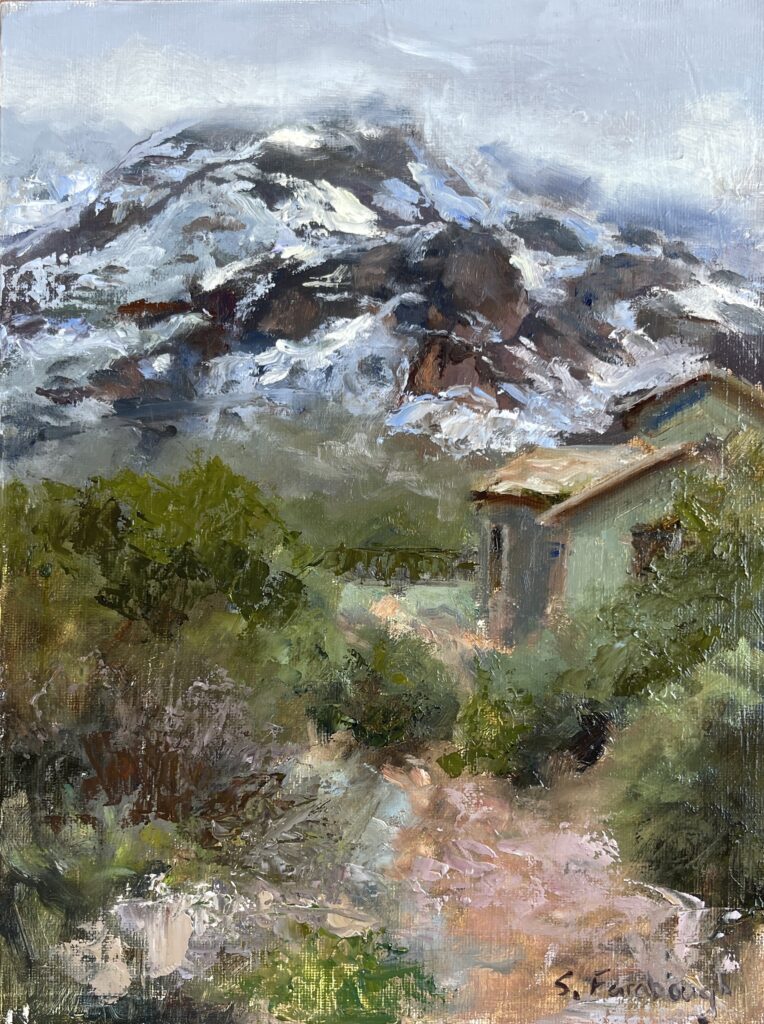I started painting at the age of 52, having no artistic training beyond high school, and absolutely loving this incredible new activity, I took every class I could find. Painting pretty much became my life. I began to win local awards and my paintings were selling well. In my first 7 or so years of painting, many of the classes I took included painting from life: models and plein air. But those paintings were just practice and rarely left my studio. Paintings that were accepted into galleries and exhibits, and paintings that won awards were all studio paintings. It became easier, and I thought more productive, to paint photos from my monitor rather than to paint from life.

And then, gradually there were more and more unfinished paintings lining the walls of my studio. Sometimes I’d work my way through the problems, but many canvases were painted over or thrown away. There were too many visual questions I couldn’t answer. Painting had become more about copying and less about interpreting or creating. A bit of the joy went out of it. I finally realized that I wasn’t challenging myself, and I wasn’t learning or making progress. Meanwhile plein air painting was gaining in popularity. Many prominent artists claimed that true color and value are seen by observing the subjects from life. We all know that photos are not accurate. After sending a photo of one of my paintings to an artist I admire for critiquing she suggested that my paintings would improve if I painted from life. That was it. I had nothing to lose. I knew I couldn’t completely step away from studio painting, so I planned to spend at least 3 days per week painting from life and 3 days in my studio.

Living in a suburb of Phoenix during the winter, I didn’t have to brave the elements and the wonderful Scottsdale Art School was handy for open studios. I assumed it would be frustrating. In fact, painting en plein air has been both exhilarating and enormously frustrating. I found that even when the paintings were pretty darned bad, painting from life was the best part of my day. In the 7 or 8 months I’ve been working at it there have been some magical and unusual moments. I’ve painted on a hilltop while bagpipes played in the distance, painted a successful painting in a rare AZ snow storm, and had my lunch stolen from my backpack right behind me by a very brave squirrel. Painting next to a stream, on a mountain top, sitting under our deck to paint the garden on a rainy day, attempting to capture the magnificence of God’s creation….those are good days no matter how the paintings turn out. I’ve never felt that in front of a monitor.
I’ve been told by seasoned plein air painters that my persistence will be rewarded gradually with more accuracy in color, value, and stronger compositions. And gradually I am feeling more comfortable and occasionally seeing some improvement. I am at the beginning of this process. Some plein air artists are painting with the intent to produce a finished painting; some use the paintings as reference for studio pieces. I’ll most likely be the latter. My slow methodical painting style does not lend itself to finishing paintings in a couple of hours, but painting from life has already taught me so much, and as I said before…..I really enjoy it. It’s a wonderful challenge, and one that I think my paintings will benefit from.

As part of this journey I’ve said “yes” to participating in two non-juried plein air events, completed paintings in both, and a couple sold! I attended the Plein Air Convention and Expo this year in Denver and found it very helpful. I entered an AZ Plein Air Painters event and that painting done in the snow was accepted. That was pretty gratifying.
If you’re getting a little stale in front of the monitor, you might think about challenging yourself to step away.

Set a date during the week when it looks like the weather will cooperate. Don’t let excuses derail you. Paint on your own or with a group; whatever you are more comfortable with. I saw painting opportunities on the path behind our house long before I got up the courage to set up there. When I finally got out it was a really easy and fun experience. People were very encouraging.

Do you have a garden? It might be easier and less intimidating to set up in front of something in your yard. I find it easiest to start with a small simple subject rather than taking on a vista. And that aligns with what I usually paint in the studio. Often I will go back to the same subject the next day (or two) and make adjustments. Looking at my painting in studio light makes it easier to see value errors. I can go out the next day and approach my subject with a more educated eye. For me, there are no rules when learning. I take as many days as I’d like to work on a painting as long as my subject is in the same light and hasn’t changed appreciably.
Challenge is good, continued learning is vital, in whatever way you find it. For me it meant getting away from something that had become a crutch. Moving away from my monitor has brought a fresh eye not just to my plein air paintings but to my studio work as well. I will trust that those plein air paintings will eventually get better, but enjoy the process meanwhile.